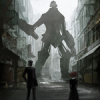Bitmap Animation Software
All of the 2D animation software I can find is all vector based. Are there programs that assist in bitmap animation? I haven't done much animation before but what I imagine to be a good program for it would be this: - I can take a base image and then copy multiple frames of it - I can modify each frame with some good editing and distortion tools to make each frame slightly different. - Maybe some tweening for more distinct objects? (or is that for vectors only?) - Maybe a feature to load video and split it frame by frame to rotoscope it My goal is to make some simple 2D animations, like some trees or grass swaying in the breeze, using digitally hand drawn pictures. I think I'll just use Photoshop, and then add a layer for each frame and edit every frame, using the translucent previous frame as reference. Is there a better way (or program) to do this? Thanks.
You could try Graphics Gale(shareware), it has a multi-frame GUI and real-time preview in editing. The method you mentioned though isn't bad either.
GyrthokNeed an artist? Pixeljoint, Pixelation, PixelDam, DeviantArt, ConceptArt.org, GFXArtist, CGHub, CGTalk, Polycount, SteelDolphin, Game-Artist.net, Threedy.
Plastic Animation Paper. Unlimited free trial; purchase a license when you're ready.
i think the tweening you are referring to is for vector graphics only, however, the word tweening comes from the word between which is actually a process used in professional hand drawn animation studios. the real animators only draw the begining and end of the actions in the animation and mark frame times and durations of the actions, then they just send the draft to the tweeners and they fill in the frames between. the family guy animators send it all the way to korea to be tweened. by the way, i use graphics gale for my pixel art animations. it works great. it even has onion skin. also, its palette features are awesome for when you need fixed palette graphics in a game! you can easily pick two colors to blend which is good for shading.
ever since i was 5, i have always loved the marriage between image and music.
Oh, so other people manually fill in the missing frames? That seems like a really efficient idea for professionals (although not one I have resources for).
What's onion skin? Actually, brb Googling.
What's onion skin? Actually, brb Googling.
onion skin is the ability to see the frame you drew before or after the frame you are working on. its like using tracing paper.
ever since i was 5, i have always loved the marriage between image and music.
Onion skin is really a reference to the traditional animation paper, which is thin and somewhat translucent, similar to the layers of an onion.
In traditional animation, the animators draw the character models and reference sheets, then draw "key frames" (this is the origin of the term keyframe) with timing information - how many frames need to be inserted between keys. The in-betweeners (basically a team of junior animators) draw the frames between keys, but at this point all of the art is still rough. Another set of artists "clean up" these drawings by tracing the core shapes, creating outlines of consistent thickness, etc (though, of course, a studio can employ one artist as both an in-betweener and for cleanup). After cleanup, the cels (so-called because the cleaned up versions were drawn on fully transparent sheets of celluloid) are ready for painting, which is done on the reverse side, often in acrylic.
As single shot of final animation is composed by layering the background, all static elements, and then all animated elements on a peg board (for uniform registration) to be photographed by an overhead camera.
Yeah, digital technology takes a lot of that tedium out. [smile]
In traditional animation, the animators draw the character models and reference sheets, then draw "key frames" (this is the origin of the term keyframe) with timing information - how many frames need to be inserted between keys. The in-betweeners (basically a team of junior animators) draw the frames between keys, but at this point all of the art is still rough. Another set of artists "clean up" these drawings by tracing the core shapes, creating outlines of consistent thickness, etc (though, of course, a studio can employ one artist as both an in-betweener and for cleanup). After cleanup, the cels (so-called because the cleaned up versions were drawn on fully transparent sheets of celluloid) are ready for painting, which is done on the reverse side, often in acrylic.
As single shot of final animation is composed by layering the background, all static elements, and then all animated elements on a peg board (for uniform registration) to be photographed by an overhead camera.
Yeah, digital technology takes a lot of that tedium out. [smile]
Wow that sounds like a lot of work for just a few seconds of animation... having to do a multi-hour length film must be a real challenge.
Thank goodness for digital art... I feel almost guilty doing the work of a whole team in half the time! Although their superior quality is something they can rightfully brag about.
Thank goodness for digital art... I feel almost guilty doing the work of a whole team in half the time! Although their superior quality is something they can rightfully brag about.
This topic is closed to new replies.
Advertisement
Popular Topics
Advertisement
Recommended Tutorials
Advertisement








